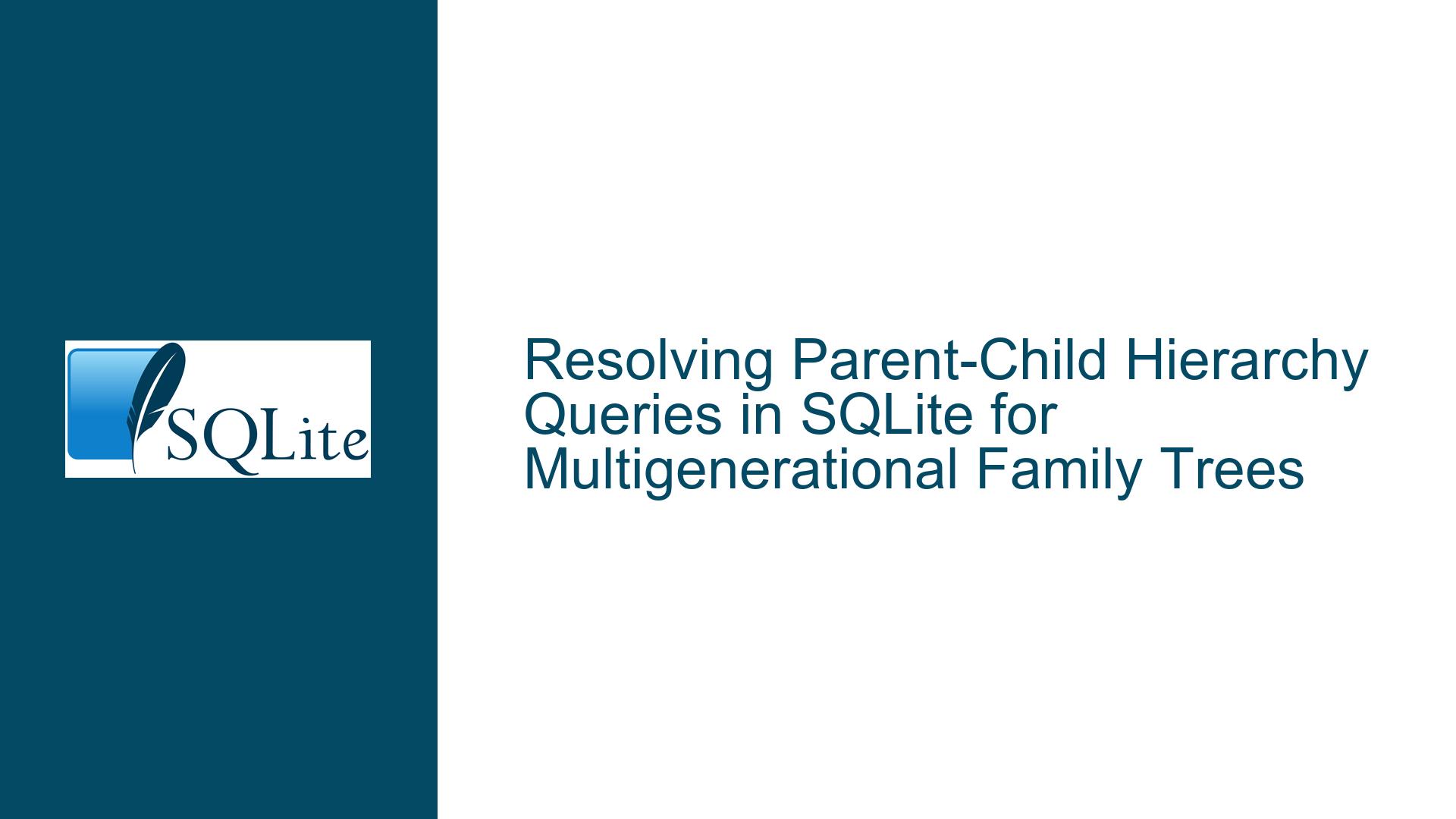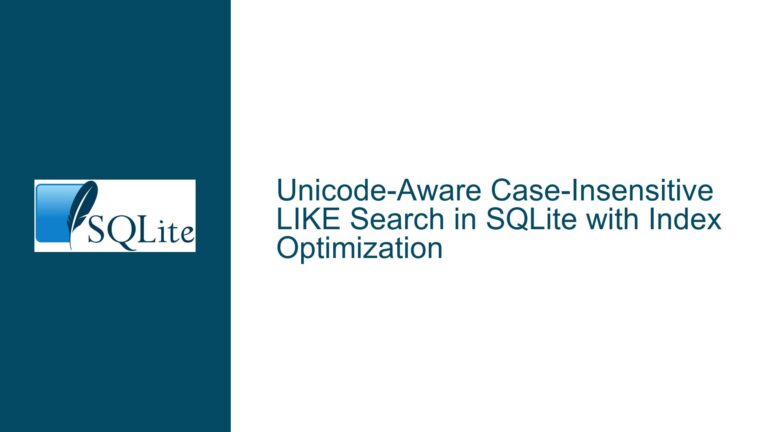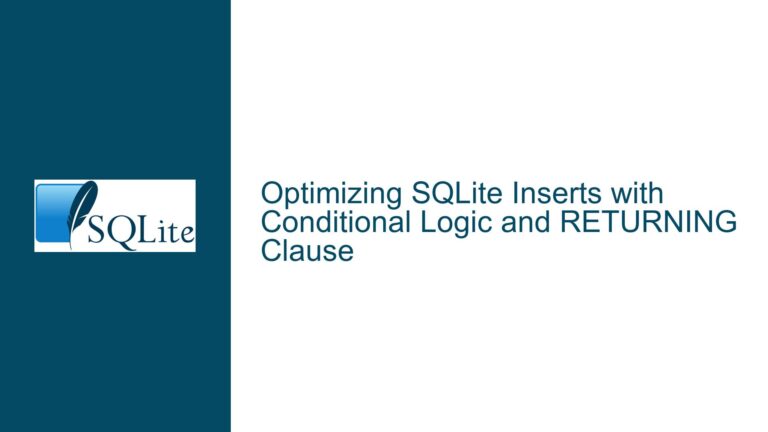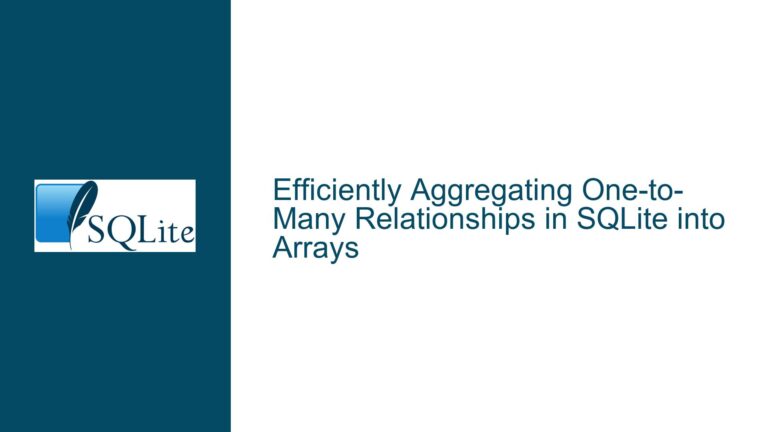Resolving Parent-Child Hierarchy Queries in SQLite for Multigenerational Family Trees
Hierarchical Data Modeling & Immediate Parent Identification Challenges
The core technical challenge revolves around accurately resolving parent-child relationships in a hierarchical data structure stored across two normalized SQLite tables. The Names table stores unique identifiers alongside individual names (e.g., Frank, Gabriel, Geoffrey), while the Relation table defines directed edges between these entities to establish familial connections (e.g., Frank → Gabriel, Geoffrey → Gordon). A naive approach of directly joining these tables fails to address scenarios requiring multigenerational traversal or identification of common ancestors when multiple descendants are provided as input filters.
Hierarchical data inherently introduces complexity due to its recursive nature – children become parents in subsequent generations, creating nested relationships. SQLite’s lack of native hierarchical query operators (like Oracle’s CONNECT BY PRIOR) necessitates careful emulation through Common Table Expressions (CTEs) and self-joins. The immediate obstacle lies in designing a query that:
- Correctly associates child entries with their direct parents
- Handles multiple input filters (children) to identify shared ancestry
- Scales efficiently as family tree depth increases
Misalignment between primary/foreign key constraints and join conditions frequently produces incomplete or erroneous parent mappings. For instance, filtering solely on child names without constraining the result set to shared parentage across all specified children leads to false positives. Additionally, overlooking SQLite’s case-sensitive string comparisons can cause mismatches between provided child names and stored values.
Primary Failure Modes in Parent-Child Relationship Resolution
Insufficient Join Conditions: Omitting necessary join predicates between the Names and Relation tables results in Cartesian products, where every parent gets erroneously paired with every child. This manifests as output containing all possible parent entries rather than only those biologically or logically connected to the specified children.
Improper Handling of Multiple Child Filters: When multiple child names are supplied (e.g., George and Gordon), a simplistic WHERE clause using IN() or OR operators retrieves parents of any listed child rather than parents common to all children. This distinction critically impacts result accuracy – without intersection logic, the query returns Geoffrey (correct parent for both) alongside Frank (parent of Gabriel and Geoffrey but not George/Gordon).
Depth Limitation in Hierarchical Traversal: The provided schema allows for multigenerational relationships (Frank → Geoffrey → George), but basic join operations only resolve immediate parentage. Queries targeting grandparents or great-grandparents necessitate recursive traversal, which standard SQL syntax cannot natively express without CTE-based iteration.
Case Sensitivity Mismatches: SQLite’s default case-sensitive comparison treats ‘george’ and ‘George’ as distinct values. Queries filtering by lowercase child names without explicit collation overrides (e.g., COLLATE NOCASE) fail to match properly capitalized entries in the Names table.
Indexing Deficiencies: Absence of composite indexes on Relation.id_parent and Relation.id_child forces full table scans during join operations, degrading performance as dataset size increases. Similarly, lacking an index on Names.names necessitates sequential searches when resolving name-to-ID mappings.
Comprehensive Resolution Strategy for Accurate Parent-Child Mapping
Step 1: Schema Validation and Index Optimization
Confirm table structures align with the following DDL, incorporating primary keys and foreign key constraints to enforce referential integrity:
CREATE TABLE Names(
id INTEGER PRIMARY KEY,
names TEXT NOT NULL
);
CREATE TABLE Relation(
id INTEGER PRIMARY KEY,
id_parent INTEGER NOT NULL,
id_child INTEGER NOT NULL,
FOREIGN KEY(id_parent) REFERENCES Names(id),
FOREIGN KEY(id_child) REFERENCES Names(id)
);
CREATE INDEX idx_relation_parent_child ON Relation(id_parent, id_child);
CREATE INDEX idx_names_name ON Names(names COLLATE NOCASE);
The composite index on Relation.id_parent and Relation.id_child accelerates parent/child lookups during joins. Case-insensitive indexing on Names.names ensures reliable name matching regardless of input capitalization.
Step 2: Immediate Parent Retrieval via Intersection Join
To identify parents shared by all specified children (George and Gordon), leverage INNER JOINs combined with COUNT() aggregation to enforce that the number of matching children per parent equals the total number of input filters:
SELECT p.names AS parent_name
FROM Names p
INNER JOIN Relation r ON p.id = r.id_parent
INNER JOIN Names c ON r.id_child = c.id
WHERE c.names IN ('George', 'Gordon')
GROUP BY p.id
HAVING COUNT(DISTINCT c.id) = 2;
This query:
- Joins parents to their children through the Relation table
- Filters parents whose children include both George and Gordon
- Groups results by parent ID to aggregate child matches
- Retains only parents with exactly 2 distinct child matches
The COUNT(DISTINCT c.id) prevents overcounting if multiple relations exist for the same parent-child pair. Adjust the HAVING clause’s equality value to match the number of input children.
Step 3: Recursive Ancestry Traversal for Multigenerational Lineage
When the target parent exists higher in the hierarchy than the immediate parent (e.g., retrieving Frank as Geoffrey’s parent when given George), employ a recursive CTE to traverse the lineage backwards:
WITH RECURSIVE Ancestry(child_id, parent_id, depth) AS (
SELECT c.id, r.id_parent, 1
FROM Names c
LEFT JOIN Relation r ON c.id = r.id_child
WHERE c.names = 'George'
UNION ALL
SELECT a.child_id, r.id_parent, a.depth + 1
FROM Ancestry a
INNER JOIN Relation r ON a.parent_id = r.id_child
)
SELECT n.names AS ancestor_name, MIN(a.depth) AS generations_removed
FROM Ancestry a
INNER JOIN Names n ON a.parent_id = n.id
GROUP BY a.parent_id
ORDER BY generations_removed;
This CTE:
- Starts from the specified child (George)
- Recursively ascends the family tree by treating each parent as a new child
- Tracks traversal depth to measure generational distance
- Returns all ancestors ordered by proximity
The LEFT JOIN in the initial CTE term accounts for root nodes (individuals without parents).
Step 4: Dynamic Input Handling with Parameterized Queries
To safely incorporate user-provided child names into the query, utilize SQLite parameters to prevent SQL injection and automate input sanitization:
import sqlite3
def get_parents(child_names):
conn = sqlite3.connect('family.db')
cursor = conn.cursor()
placeholders = ','.join(['?'] * len(child_names))
query = f"""
SELECT p.names
FROM Names p
INNER JOIN Relation r ON p.id = r.id_parent
INNER JOIN Names c ON r.id_child = c.id
WHERE c.names IN ({placeholders})
GROUP BY p.id
HAVING COUNT(DISTINCT c.id) = ?;
"""
cursor.execute(query, (*child_names, len(child_names)))
return cursor.fetchall()
This Python function dynamically adjusts the IN clause and HAVING count based on the number of child names provided.
Step 5: Collation-Aware Name Matching
Override SQLite’s default case sensitivity by applying COLLATE NOCASE to name comparisons, ensuring ‘george’ matches ‘George’:
SELECT p.names
FROM Names p
INNER JOIN Relation r ON p.id = r.id_parent
WHERE r.id_child IN (
SELECT id FROM Names WHERE names = 'george' COLLATE NOCASE
);
For optimal performance, create the Names.names index with NOCASE collation as shown in Step 1.
Step 6: Visualization and Debugging through Temporary Lineage Tables
Construct a temporary table to materialize the family tree for visual verification:
CREATE TEMP TABLE LineageVisualization AS
WITH RECURSIVE FamilyTree(id, name, parent_id, depth, path) AS (
SELECT id, names, NULL, 0, names
FROM Names
WHERE id NOT IN (SELECT id_child FROM Relation)
UNION ALL
SELECT n.id, n.names, r.id_parent, ft.depth + 1,
ft.path || ' → ' || n.names
FROM Names n
INNER JOIN Relation r ON n.id = r.id_child
INNER JOIN FamilyTree ft ON r.id_parent = ft.id
)
SELECT * FROM FamilyTree
ORDER BY depth, name;
SELECT * FROM LineageVisualization;
This produces an indented hierarchy showing each individual’s lineage path:
id | name | parent_id | depth | path
1 | Frank | NULL | 0 | Frank
2 | Gabriel | 1 | 1 | Frank → Gabriel
3 | Geoffrey | 1 | 1 | Frank → Geoffrey
4 | George | 3 | 2 | Frank → Geoffrey → George
5 | Gordon | 3 | 2 | Frank → Geoffrey → Gordon
6 | Heather | 3 | 2 | Frank → Geoffrey → Heather
Step 7: Performance Tuning for Large Family Trees
For datasets exceeding 10,000 relationships, employ covering indexes and materialized path optimizations:
-- Covering index for child-to-parent lookups
CREATE INDEX idx_relation_child_parent ON Relation(id_child, id_parent);
-- Materialize path strings for frequent ancestry queries
ALTER TABLE Names ADD COLUMN path TEXT;
CREATE INDEX idx_names_path ON Names(path);
WITH RECURSIVE PathBuilder AS (...);
UPDATE Names SET path = ...;
Periodically rebuild materialized paths during low-usage periods to maintain consistency with the Relation table.
Step 8: Handling Complex Kinship Patterns
Extend the solution to address half-siblings, adoptive relationships, and multiple parents through schema augmentation:
ALTER TABLE Relation ADD COLUMN relationship_type TEXT CHECK(
relationship_type IN ('biological', 'adoptive', 'step')
);
ALTER TABLE Relation ADD COLUMN parent_order INTEGER; -- For ordered children
Modify queries to factor in relationship types when required:
SELECT DISTINCT p.names
FROM Names p
INNER JOIN Relation r ON p.id = r.id_parent
WHERE r.id_child IN (SELECT id FROM Names WHERE names IN ('George', 'Gordon'))
AND r.relationship_type = 'biological';
Step 9: Integration with Application Logic
Implement application-level caching of frequent parent-child queries using SQLite’s in-memory databases or external caching systems:
ATTACH DATABASE ':memory:' AS cache;
CREATE TABLE cache.parent_map AS
SELECT c.id AS child_id, p.id AS parent_id
FROM Names c
JOIN Relation r ON c.id = r.id_child
JOIN Names p ON r.id_parent = p.id;
Query the cached mapping table for improved response times:
SELECT p.names
FROM cache.parent_map pm
JOIN Names p ON pm.parent_id = p.id
WHERE pm.child_id IN (SELECT id FROM Names WHERE names IN ('George', 'Gordon'));
Step 10: Comprehensive Validation through Unit Testing
Develop a test harness using SQLite’s TCL extension to verify query accuracy across edge cases:
-- Test case: Multiple children with shared parent
INSERT INTO Names VALUES (7, 'TestParent'), (8, 'TestChild1'), (9, 'TestChild2');
INSERT INTO Relation VALUES (10, 7, 8), (11, 7, 9);
SELECT names FROM Names
WHERE id IN (
SELECT p.id
FROM Names p
INNER JOIN Relation r ON p.id = r.id_parent
INNER JOIN Names c ON r.id_child = c.id
WHERE c.names IN ('TestChild1', 'TestChild2')
GROUP BY p.id
HAVING COUNT(DISTINCT c.id) = 2
);
-- Expected result: TestParent
Automate test execution using SQLite’s command-line interface:
sqlite3 family.db < tests.sql
Final Implementation Checklist
- Validate schema constraints and indexes
- Employ parameterized queries with dynamic input handling
- Utilize recursive CTEs for multigenerational ancestry
- Implement collation-aware string matching
- Materialize frequently accessed lineage paths
- Cache query results where appropriate
- Establish automated test coverage
- Monitor query performance with EXPLAIN QUERY PLAN
- Regularly reindex tables to maintain optimal performance
- Document all hierarchy-specific query patterns
By systematically applying these techniques, developers can reliably resolve parent-child relationships in SQLite hierarchies while ensuring scalability and maintainability. The combination of proper indexing, recursive query constructs, and careful input sanitization addresses both immediate parent identification and complex multigenerational traversal requirements.






